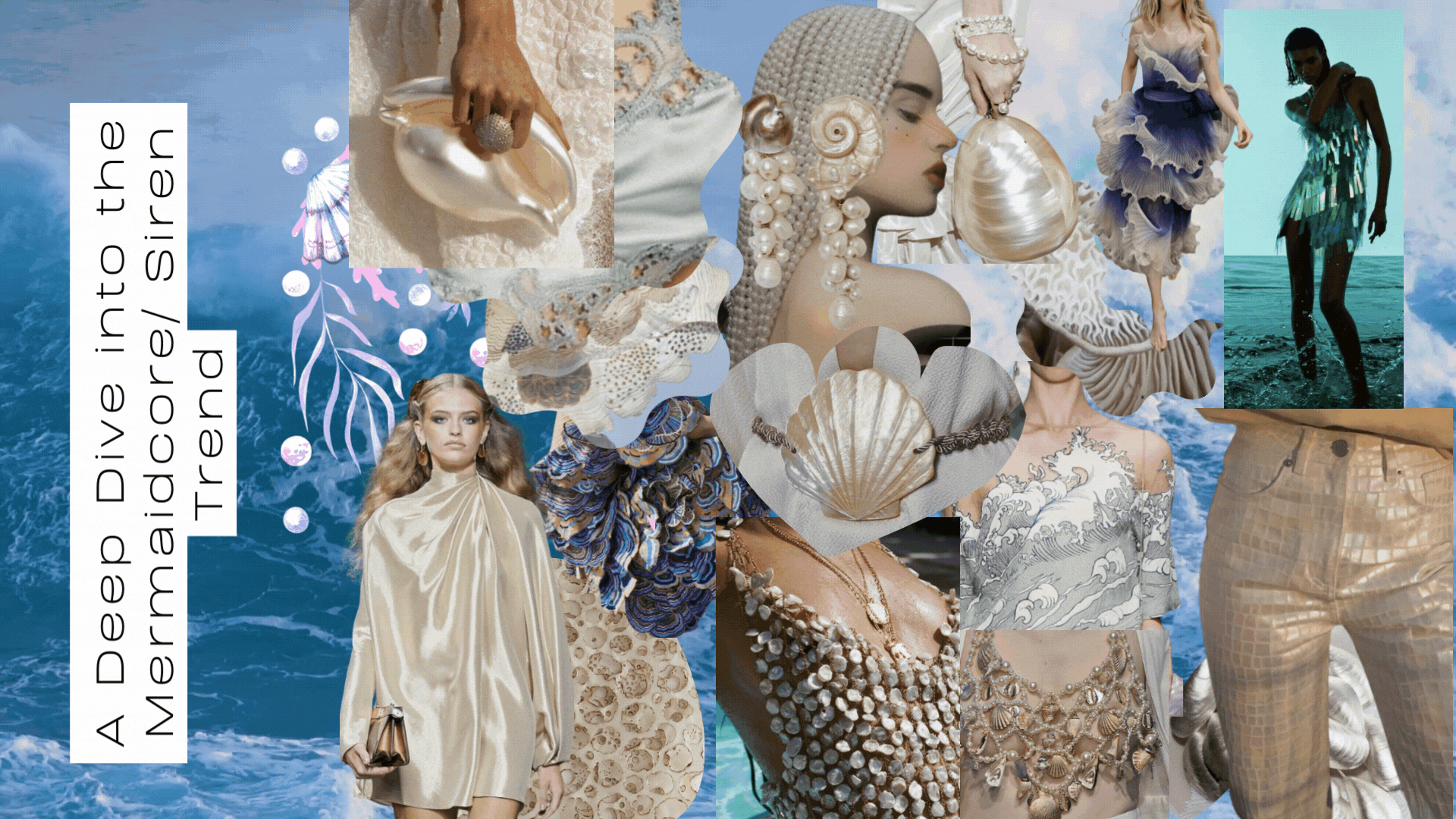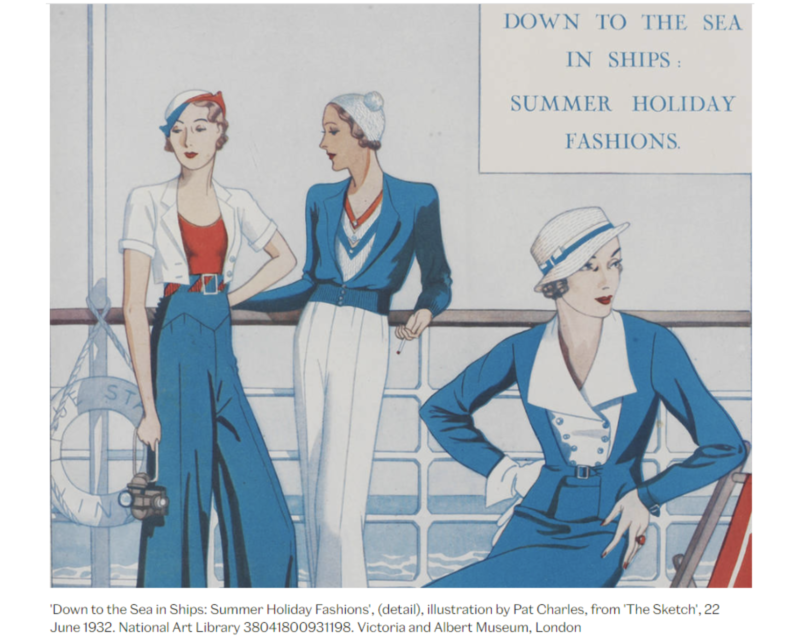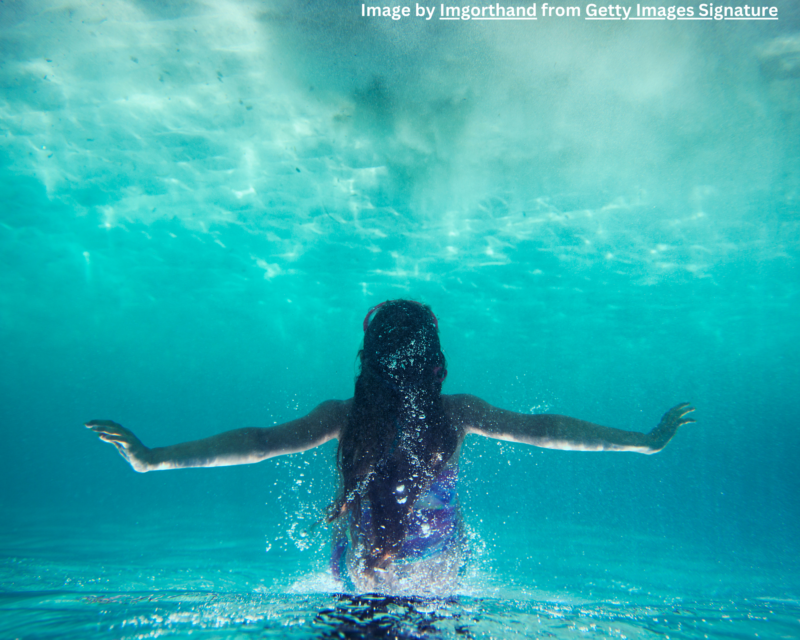
Summer’s Hottest Fashion Trend? A Deep Dive Into Mermaidcore
What is fashion design but an elevation of the mundane? After all, a blouse that costs $800, or more, requires its designer to convince us that what began as a scrap of fabric has, through the alchemy of design, been transformed into something so spectacular it must be priced into a stratosphere unattainable by many. From a new materialism perspective, the design, not the materials used for manufacture, is often presented as the value proposition. Such logic requires that we, as consumers, pay a premium for the logo of the designer, rendering the quality of the materials as incidental and the purpose of the fashion as irrelevant. Yet, in a world under siege by climate fluctuation, mermaidcore, one of the primary fashion trends of spring/summer 2023, invites us to experience the connection of materials to purpose as transcendent and supreme.
From the mysterious depths of the sea, mermaidcore submerges the senses, utilizing layers of flowy, floaty, silky, sheer fabrics, hued in shades that run from vibrant oranges, yellows, and the pinks of coral reefs to the green and blue of deep waters. While we’re calling the trend mermaidcore, the aesthetic has been called everything under the sea: mermaidcore, Siren, Airy, and Whimsical to name a few examples. As a recurring trend, mermaidcore has been solidifying into a clearly definable aesthetic for several years.
Of all the fashion trends from spring/summer 2023, mermaidcore offers more than just interesting trend notes. It is a subtle reminder to value the world around us. Good design is a marriage of skill with the chosen material. Moreover, it encourages us to understand that truly good design is the ability to skillfully fabricate in a way that celebrates the material and honors the natural world. This reflects elevated design far more than any designer logo ever could.
So let’s take a deep dive (pun intended) into summer’s hottest fashion trend.

High Fashion Seas
The ocean has long been fashion’s muse, offering much exploration and inspiration. French couturier Marcel Rochas is credited with inventing the mermaid silhouette in the 1930s, and French designer Jean Patou had an aquatic inspired gown splashed across the pages of Vogue in 1933. In more recent memory, Versace’s 1992 spring/summer collection, Trésor de la Mer (Treasure of the Sea), featured colorful sea life like starfish and shells. Alexander McQueen’s 2010 spring/summer collection, Plato’s Atlantis, took inspiration from the fictious island of Atlantis and worries of climate change. The fashion and models morphed into hybrid reptilian, almost alien like animals that could survive rising sea levels. It was also the first fashion show ever live streamed on the internet.
In 2018, cult favorite brand Selkie, inspired by Celtic and Norse folklore, was launched by Kimberley Gordon. Gordon found inspiration in the myth of the selkie, a creature that appears as a seal and a woman when the seal skin is shed. If the seal skin is stolen, the selkie will have to live on land and often is forced into a marriage with the man who stole the skin. When the skin is found, the selkie wins her freedom back and can return to the ocean as her true self. The brand’s size inclusive, fantastical, whimsical, and ethereal party dresses often evoke the marine nature of the brand’s namesake.
Socialite Kim Kardashian’s 2019 House of Mugler Met Gala look was yet another stop on fashion’s ocean inspired obsession. Thierry Mugler envisioned Kim as a California girl stepping out of the ocean, dripping wet. The oil slicked skin, wet hair and makeup look furthered the image of Kim having just stepped out the ocean deep, dripping with jeweled water droplets.
While this certainly isn’t a comprehensive list of ocean themed fashion moments, it does illustrate how sea themed trends have ebbed and flowed in the cultural zeitgeist so it’s no surprise that the waters of the natural world are once again rising in our cultural consciousness.

Beyond Fashion
Late 2020 and 2021 mark the beginning of our most recent ocean fascination. Simone Rocha’s autumn/winter 2020/2021 collection was focused on baptism by the sea with elements of underwater life in the form of shark teeth, pearl encrusted net bags, and her signature use of pearls. Versace paid homage to their previous 1992 collection by bringing back starfish and marine themed prints for Spring/Summer 2021. Rixo and 16Arlington’s spring/summer 2021 collections were both inspired by mermaids, while Burberry’s show found inspiration in the love between a mermaid and a shark. Iris van Herpen, whose collections often take inspiration from the ocean, used her spring/summer 2021 collection as a continuation on her previous Sensory Seas collection.
While there were many ocean-themed runway shows in 2021, it can take some time before the trends trickle down to the masses. By 2022 we saw the mermaidcore trend take on many forms, from interiors, fashion, and even makeup. Over the course of 2022, interiors and decor saw the rise of the crustaceancore/lobstercore trend, which focused on creatures of the sea, from star fish, mermaids, shells, or, as the core title suggests, lobsters. In 2022, handcraft and vintage marketplace, Etsy, saw 122% increase in searches for lobster prints, a 31% increase in searches for oyster art, and a 5% increase in searches for sea creature or crustacean items as compared to the same time frame in the previous year.
This interest means that the natural world has become an evergreen trend with staying power. It has a long history with a rich source of inspirational references and numerous intersects with related trends. It has been featured prominently on the runway and has continuing interest on platforms like TikTok, Etsy, and Pinterest. 2023 runway shows saw a return of more ocean-themed fashion shows from Blumarine, Erdem, Victoria Beckham, Bottega Veneta, Balmain, and Alaïa to name a few of the designers that took on natural world inspired fashions.
On the makeup side of things, we saw siren eyes go viral on TikTok in 2022. The eye makeup trend was a fresh take on a smokey eye but with more of an angle to lift the eye and give a sultry and feminine vibe to the classic smokey eye.
If all that wasn’t enough, as of the writing of this article, the mermaidcore hashtag on TikTok has 151.6 million views. The ocean hasn’t just overtaken our interiors, makeup, and fashion, it’s also monopolizing our foods as well. As a key food trend for 2023, Pinterest saw searches for ‘nori recipes’ and ‘green algae’ up 60%, and ‘seaweed snack recipes’ up 245%. On TikTok, the trendy algae superfood, sea moss, had over 567.7 million views.

A History in the Deep
While the argument has been made that the ocean has completely taken over our social consciousness, the question remains. Why now? From a historical perspective, fashion’s obsession with the ocean as a theme is not new. From a strictly Western context, this interest in representing the ocean in fashion can be traced back to the seafaring nation of Great Britain. In April 1748, the British Royal Navy began wearing standardized uniforms designed to endure the elements that sailors faced at sea. A secondary goal of the uniforms was to create a sense of recognition and respectability. Almost immediately, nautical military fashion inspired civilian clothing. Almost one hundred years later, the trend rose to prominence again after Queen Victoria dressed her eldest son, Albert Edward, in a sailor suit in 1846. This made the style fashionable among the gentry of England, and it became a popular children’s style. In this way, nautical fashion became synonymous with status, respectability, and fashion sense.
With America’s close historical ties to Britain, fashion styles were often imported, although, on a delay, as the distance between the colonies and Britain meant that fashions were often out-of-date by the time they reached America. Even so, American colonist maintained social stratification by importing British fabrics and fashions. Even as anti-British sentiments arose, and boycotts and anti-importation began in the 1760’s, it was hard for many colonists to give up British fashion, as doing so blurred social lines. Today, we can still see social stratification as well as strong nautical and ocean inspired influences in both British and American fashions, especially in elite luxury and resort wear looks.
Another context for fashion’s ocean influence is trans-Atlantic travel on ocean liners during the 20th century. It is here that fashion, through ocean travel, became synonymous with escapism and luxury. According to the Victoria and Albert Museum of London, “Dressing on an ocean liner was more than a case of being practical at sea. To embark on an ocean voyage was to enter a realm of transformative glamour and escapist fantasy. It was an opportunity to see and be seen by the social elite, and fashion became central to the experience.” Ocean liners furthered the connection, depicting elegantly dressed passengers on advertising brochures. These ocean liners became more and more like floating palaces based off hotels like the Ritz Carlton or stately country homes. Fashion periodicals like Vogue often gave advice on how to dress when making a trans-Atlantic voyage because the ship was merely a backdrop for fashion and social posturing, whether it be boarding the ship in the recommended tweed suits or coming down the staircase to enter the dining room in elegant chiffon and lace dresses.
Given the innumerable ways that the ocean has been employed as a theme, it has also come to represent luxury and status in fashion. Beyond the historical, it also plays into our psychology. Perhaps the reason the current season of fashion design has been so rife with ocean themes is because of the many symbolic interpretations the ocean offers and how they can connect to our own psychological state. The psychiatrist Carl Jung felt that the sea symbolized the personal and the collective unconscious. Beyonce Knowles put her own spin on this idea saying, “The ocean puts my whole life into perspective…it humbles me and grounds me. It makes me feel almost like I’ve been baptized, and I’m born again when I get out of the ocean.”
Beyond the psychological, there are very real ecological concerns in regard to our oceans. The ocean is an ecosystem at the forefront of climate change. As the largest contributor of microplastic pollution, fashion is inextricably linked to the ocean. Through various processes, synthetic fibers like polyester produce tiny particles of plastic when washed. These microplastics enter the ocean through wastewater causing harm to marine biomes and entering our food chain. Designers like Botter and Iris van Herpen have used their fashion collections to speak to the environmental impact fashion has on the ocean. For example, Botter’s fall/winter 2021 show, which was embellished with fishing tackle and windbreakers made from recycled ocean plastics, included the manifesto: “without the sea, no human, no us.” The brand also announced that they had set up a coral nursery in the Caribbean.
It is an interesting dichotomy in which the ocean is a source of inspiration and yet through that inspiration harm is done to the environment.
Leaving the psychological and ecological reasons for fashion’s ocean obsession behind, pop culture and timing aren’t to be ignored. For one, we can’t escape seasonality. Every spring/summer runway show has some form of floral, perhaps because spring brings forth the idea of florals in bloom. Just like flowers are a reoccurring spring trend, so too is the ocean, as we begin to consider vacation destinations. Choices for vacations are often location specific, the city, the mountains, or the beach. Water, beach, vacation, such words are simply synonymous with spring and summer.

A Call to Nostalgia
A final reason for why we have returned to the sea, is the release of the Disney live action film, The Little Mermaid, released May 26th, 2023. The movie, which has grossed $554 million worldwide so far, relied heavily on the general nostalgia trend, which is currently dominating more than just fashion. The original Little Mermaid movie was released in 1989 and has a lifetime box office of $235 million worldwide, making the original Disney cartoon nostalgic for many. Add to that other 2000 era movies like Aquamarine, Avatar, (and it’s recent sequel Avatar: The Way of Water), and the Pirates of the Caribbean franchise, and we start hitting on the Y2K nostalgia craze that has been dominating fashion for the past several years. Perhaps, in the here and now, there is no other choice but to be mermaid obsessed as we are submerged in both nostalgia and the realities of how our modern life impacts our oceans.
Part of their world…
On one hand, the ocean, mermaids, sirens, selkies, tap into a common mythos, one that reminds us of childhood, cultural stories, and escapism. On the other hand, the ocean is unknown, there is still much to be discovered. In this way, it may act as a perfect metaphor for the past several years with the pandemic.
As we resurface from the deep waters of the mermaidcore fashion trend, one question remains, how can you ride the waves of summer’s hottest fashion trend? The answer is rather easily as the trend is quite broad and splashes in colors of deep and light blues, pearl white, sea foam greens, light pinks and light browns. As for silhouette, make it maxi with Mermaid maxi skirt silhouettes, paired with bra tops. Or go for a slinky maxi dress. Pick fabrics that are shiny, light, and ephemeral like organza, or silks, or go for nautical fabrics like crochet knit to create that mermaid caught in a net vibe. Ruching, paillette sequins and pearl embellishments can connect mermaidcore to 2024’s embellished trend. To accessorize, look for jewelry with pearls, sea glass, seashells, and/or netted materials.
The mermaidcore hype will likely recede with the tide by next year; however, the ocean is vast and deep and has much more to offer in terms of fashion inspiration and innovation. As we grapple with climate change, environmentally friendly fashion, and reusing recycled materials like plastics found in the ocean, the relationship between fashion and the ocean is in for a long-haul voyage. The ocean is embedded into our very DNA. It represents our pasts, it highlights societal stratification, reminds us of war, of life, of travel and fun. With all the deepness of the sea, it will be interesting to watch how fashion seeks inspiration from the ocean to again enchant us.
WAIT!
Want to bring mermaidcore to your home, check out our Seashell Décor DIYs
Hungry for more? Check out our Blue Ocean and Sea Foam Chia Seed Pudding Recipe
Resources:
https://www.vogue.co.uk/fashion/article/ocean-inspired-fashion
https://www.pinterest.com/today/best/airy-styles/104657/
https://www.glamour.com/story/airy-styles-fashion-trend-shop
https://www.refinery29.com/en-us/2022/12/11236033/fashion-style-aesthetics-2023-list
https://www.allure.com/story/siren-eyes-tiktok-trend
https://fashionista.com/2018/08/alexander-mcqueen-spring-2010-platos-atlantis
https://selkiecollection.com/pages/about-selkie
https://www.harpersbazaar.com/uk/fashion/fashion-news/a27387049/kim-kardashian-mugler-met-gala-2019/
https://www.teenvogue.com/story/selkie-tiktok-famous-puff-dress-inclusive-fashion
https://www.thezoereport.com/living/crustaceancore-home-decor-trend
https://www.thezoereport.com/fashion/coastal-grandmother-fashion-trend
https://fashionmagazine.com/style/trends/what-is-mermaidcore/
https://www.archiefoal.com/blogs/journal/history-nautical-fashion-clothing
https://www.american.edu/cas/news/kate-haulman-politics-fashion.cfm
https://www.commonobjective.co/article/microfibres-what-to-know-and-do-beatplasticpollution
https://justoneocean.org/portfolio/the-fashion-industrys-impact-on-the-ocean
